1. 为什么需要智能指针?
下面我们先分析一下下面这段程序有没有什么内存方面的问题?
- 场景一
// 如果p1和p2 new不会抛异常,仅仅只考虑div()会出现异常
int div()
{
int a, b;
cin >> a >> b;
// 如果函数div()出现除0错误,则会抛异常
if (b == 0)
throw invalid_argument("除0错误");
return a / b;
}
void Func()
{
// 1、如果p1这里new 抛异常会如何?
// 如果是p1抛异常,那么就会直接跳转到main()函数对应的catch()中,此时并没有需要去释放的资源,因此是不需要处理的
int* p1 = new int;
// 2、如果p2这里new 抛异常会如何?
// 此时p1的资源已经被申请了,如果说,此时p2抛异常,那么就会直接跳转到main()函数对应的catch()中,然而p1申请的资源并没有被释放,这样就会造成内存泄漏
int* p2 = new int;
// 如果div()会抛异常,那么throw后会直接跳转到main()函数,这样的话p1和p2就不会被释放,那样就会造成内存泄漏
cout << div() << endl;
delete p1;
delete p2;
}
int main()
{
try
{
Func();
}
catch (exception& e)
{
cout << e.what() << endl;
}
return 0;
}
- 场景二
int div()
{
int a, b;
cin >> a >> b;
if (b == 0)
throw invalid_argument("除0错误");
return a / b;
}
void func()
{
// p1抛异常,没有要释放的资源,所以不会造成内存泄漏
int* p1 = new int[10];
// p2初始化
int* p2 = nullptr;
try
{
// p2抛异常,因为p2被try块保护,所以跳转到下面的catch块里面,会先释放p1的资源,再处理异常
// 因此不会造成内存泄漏,div() 同理
// 这样的处理方式是正确的,但是代码会十分冗余
// 如果还有p3、p4等等也要抛异常呢,这样就会变得十分冗余和复杂了
// 因此才有了智能指针的提出,来解决这个问题
p2 = new int[20];
try
{
cout << div() << endl;
}
catch (...)
{
delete[] p1;
delete[] p2;
throw;
}
}
catch (...)
{
delete[] p1;
//...
}
delete[] p1;
delete[] p2;
}
int main()
{
try
{
func();
}
catch (exception& e)
{
cout << e.what() << endl;
}
return 0;
}
2.智能指针
2.1 RAII
- **RAII(Resource Acquisition Is Initialization)**是一种利用对象生命周期来控制程序资源(如内存、文件句柄、网络连接、互斥量等等)的简单技术。
- **在对象构造时获取资源,接着控制对资源的访问使之在对象的生命周期内始终保持有效,最后在对象析构的时候释放资源。**借此,我们实际上把管理一份资源的责任托管给了一个对象。这种做法有两大好处:
- 不需要显式地释放资源。
- 采用这种方式,对象所需的资源在其生命期内始终保持
// 智能指针的类模板
template<class T>
class SmartPtr
{
public:
// 构造函数
SmartPtr(T* ptr)
:_ptr(ptr)
{}
// 析构函数
~SmartPtr()
{
delete[] _ptr;
cout << _ptr << endl;
}
private:
T* _ptr;
};
// 除法函数
int div()
{
int a, b;
cin >> a >> b;
if (b == 0)
throw invalid_argument("除0错误");
return a / b;
}
- 使用智能指针
1、如果p1这里new 抛异常会如何?
2、如果p2这里new 抛异常会如何?
3、如果div()调用这里又会抛异常会如何?
void Func()
{
// 如果是p1抛异常,那么就会直接跳转到main()函数对应的catch()中,此时并没有需要去释放的资源,因此是不需要处理的
int* p1 = new int[10];
SmartPtr<int> sp1(p1);
// 如果是p2抛异常,那么就会直接跳转到main()函数对应的catch()中,此时p1申请的资源是需要进行释放的,但是此时p1的资源是归智能指针的对象sp1管理的,因次当抛异常跳转到main()之后,栈帧还是是正常销毁,当Func()的栈帧销毁,对象sp1就会调用p1的析构函数,将它的资源进行释放,因此p1申请的资源会被释放,并不会造成内存泄漏
int* p2 = new int[20];
SmartPtr<int> sp2(p2);
// 当div()抛异常时,跳转到main(),Func()的栈帧销毁,sp1和sp2会调用p1和p2的析构函数,释放p1和p2管理的资源,并不会造成内存泄漏。
cout << div() << endl;
// 可以自己进行调试查看,以下是我调试的结果,p1和p2都被释放了
// 1 0
// 00B85EC0
// 00B86058
// 除0错误
}
int main()
{
try
{
Func();
}
catch (exception& e)
{
cout << e.what() << endl;
}
return 0;
}
2.2 像指针一样(Smartptr)
上述的SmartPtr还不能将其称为智能指针,因为它还不具有指针的行为。指针可以解引用,也可以通过->去访问所指空间中的内容,因此:SmartPtr模板类中还得需要将* 和 ->重载下,才可让其像指针一样去使用。
- 智能指针的类模板
template<class T>
class SmartPtr
{
public:
// 构造函数和析构函数,被称为RAII
// 构造函数用来保存资源
SmartPtr(T* ptr)
:_ptr(ptr)
{}
// 析构函数用来释放资源
~SmartPtr()
{
delete[] _ptr;
delete _ptr;
cout << _ptr << endl;
}
// *,->,[]的重载被称为像指针一样,也就是像指针一样去使用
T& operator*()
{
return *_ptr;
}
T* operator->()
{
return _ptr;
}
T& operator[](size_t pos)
{
return _ptr[pos];
}
private:
T* _ptr;
};
- 使用智能指针
int div()
{
int a, b;
cin >> a >> b;
if (b == 0)
throw invalid_argument("除0错误");
return a / b;
}
void Func()
{
// 此时可以通过智能指针(解引用,或者->)访问new的资源,而不需要通过p1/p2
SmartPtr<int> sp1(new int[10]);
SmartPtr<int> sp2(new int[20]);
*sp1 = 10;
sp1[0]--;
cout << *sp1 << endl; // 打印结果为9
cout << div() << endl;
}
int main()
{
try
{
Func();
}
catch (exception& e)
{
cout << e.what() << endl;
}
return 0;
}
2.3 std::auto_ptr
-
C++98版本的库中就提供了auto_ptr的智能指针。下面演示的auto_ptr的使用及问题。 -
auto_ptr的实现原理:管理权转移的思想,下面简化模拟实现了一份qwy::auto_ptr来了解它的原理。 -
对于
auto_ptr我们仅限于了解,拒绝使用它。
namespace qwy
{
// 智能指针的类模板
template<class T>
class auto_ptr
{
public:
// RAII
// 保存资源
auto_ptr(T* ptr)
:_ptr(ptr)
{}
// 释放资源
~auto_ptr()
{
// delete[] _ptr;
delete _ptr;
cout << _ptr << endl;
}
// 拷贝构造
// ap2(ap1);
// 将ap1.ptr置空了
// 此处不可以使用const修饰auto_ptr<T>& sp,否则_ptr(sp._ptr)初始化之后,_ptr的权限也会被缩小
auto_ptr(auto_ptr<T>& sp)
:_ptr(sp._ptr)
{
// 将原始的智能指针置空。因为一份资源,只能够由一个智能指针进行管理
sp._ptr = nullptr;
}
// 像指针一样
T& operator*()
{
return *_ptr;
}
T* operator->()
{
return _ptr;
}
T& operator[](size_t pos)
{
return _ptr[pos];
}
private:
T* _ptr;
};
}
int main()
{
qwy::auto_ptr<int> ap1(new int);
qwy::auto_ptr<int> ap2(ap1);// 拷贝之后,ap1变为了空指针
(*ap2)++;
// 根据auto_ptr的底层,此时ap1.ptr已经被置为空指针了,因此此处会报错
(*ap1)++;
return 0;
}
2.4 std::unique_ptr
为了防止auto_ptr的问题,unique_ptr应运而生,其原理:简单粗暴 – >防拷贝(防止智能指针对象被拷贝)。
namespace qwy
{
// 智能智能指针的类模板
template<class T>
class unique_ptr
{
public:
// RAII
// 保存资源,构造函数
unique_ptr(T* ptr)
:_ptr(ptr)
{}
// 释放资源,析构函数
~unique_ptr()
{
// delete[] _ptr;
delete _ptr;
cout << _ptr << endl;
}
// 防拷贝(禁用拷贝构造函数)
unique_ptr(const unique_ptr<T>& up) = delete;
// 防赋值 (禁用赋值重载函数)
unique_ptr<T>& operator=(const unique_ptr<T>& up) = delete;
// 像指针一样
T& operator*()
{
return *_ptr;
}
T* operator->()
{
return _ptr;
}
T& operator[](size_t pos)
{
return _ptr[pos];
}
private:
T* _ptr;
};
}
int main()
{
qwy::unique_ptr<int> up1(new int);
// 此处会报错,因为unique_ptr类型的智能指针对象是禁止被拷贝的
qwy::unique_ptr<int> up2(up1);
return 0;
}
2.5 std::shared_ptr
shared_ptr的原理:是通过引用计数的方式来实现多个shared_ptr对象之间共享资源。
- shared_ptr在其内部,给每个资源都维护了着一份计数,用来记录该份资源被几个对象共享。
- 在对象被销毁时(也就是析构函数调用),就说明自己不使用该资源了,对象的引用计数减一。
- 如果引用计数是0,就说明自己是最后一个使用该资源的对象,必须释放该资源;
- 如果不是0,就说明除了自己还有其他对象在使用该份资源,不能释放该资源,否则其他对象就成野指针了。
- 智能指针的类模板
namespace qwy
{
// 智能指针的类模板
template<class T>
class shared_ptr
{
public:
// RAII
// 保存资源
// _pcount(new int(1)),在堆上面开一块空间来存放这个计数
// 构造函数,将创建的int类型的变量初始化为1,表示现在只有一份资源
// 将资源的指针初始化给_ptr
shared_ptr(T* ptr)
:_ptr(ptr)
, _pcount(new int(1))
{}
// 析构函数
~shared_ptr()
{
Release();
}
// 拷贝构造,也就是增加计数
shared_ptr(const shared_ptr<T>& sp)
:_ptr(sp._ptr)
, _pcount(sp._pcount)
{
++(*_pcount); // 计数++
}
// 释放一份资源,计数器--
void Release()
{
if (--(*_pcount) == 0)
{
delete _pcount;
delete _ptr;
}
}
// sp1 = sp1; 两侧为同一个对象
// sp1 = sp2; 两侧间接为同一个对象(sp2是sp1拷贝的对象)
shared_ptr<T>& operator=(const shared_ptr<T>& sp)
{
// 如果两个智能指针管理的资源不相同
if (_ptr != sp._ptr)
{
// sp1 = sp4
// 将sp4赋值给sp1,那么为了防止赋值后,sp1的原有的资源无人管理,造成内存泄漏,那么首先需要将sp1进行释放,再进行赋值
// sp1调用的Release(), this->Release()
Release();
_pcount = sp._pcount;
_ptr = sp._ptr;
++(*_pcount);
}
// *this就是赋值后得到的对象
return *this;
}
// 像指针一样
T& operator*()
{
return *_ptr;
}
T* operator->()
{
return _ptr;
}
T& operator[](size_t pos)
{
return _ptr[pos];
}
private:
T* _ptr;
int* _pcount; // 计数器
};
}
- 使用智能指针
int main()
{
qwy::shared_ptr<int> sp1(new int(0));
qwy::shared_ptr<int> sp2(sp1);
qwy::shared_ptr<int> sp3(sp2);
(*sp1)++;
(*sp2)++;
cout << *sp1 << endl;
cout << *sp2 << endl;
// 打印结果为:
// 2
// 2
sp1 = sp2;
qwy::shared_ptr<int> sp4(new int(10));
qwy::shared_ptr<int> sp5(sp4);
sp1 = sp4;
return 0;
}
3.Shared_Ptr的线程安全问题
SmartPtr.h
#pragma once
#pragma once
#include <thread>
#include <mutex>
// 1、RAII
// 2、像指针一样使用
// 3、拷贝问题
namespace qwy
{
// 智能指针的类模板
template<class T>
class shared_ptr
{
public:
// RAII
// 保存资源
// _pcount(new int(1)),在堆上面开一块空间来存放这个计数
// 构造函数,将创建的int类型的变量初始化为1,表示现在只有一份资源
// 将资源的指针初始化给_ptr
shared_ptr(T* ptr)
:_ptr(ptr)
, _pcount(new int(1))
{}
// 析构函数
~shared_ptr()
{
Release();
}
// 拷贝构造,也就是增加计数
shared_ptr(const shared_ptr<T>& sp)
:_ptr(sp._ptr)
, _pcount(sp._pcount)
{
++(*_pcount); // 计数++
}
// 释放一份资源,计数器--
void Release()
{
if (--(*_pcount) == 0)
{
delete _pcount;
delete _ptr;
}
}
// sp1 = sp1; 两侧为同一个对象
// sp1 = sp2; 两侧间接为同一个对象
shared_ptr<T>& operator=(const shared_ptr<T>& sp)
{
if (_ptr != sp._ptr)
{
// sp1 = sp4
// 将sp4赋值给sp1,那么为了防止赋值后,sp1的原有的资源无人管理,造成内存泄漏,那么首先需要将sp1进行释放,再进行赋值
// sp1调用的Release(), this->Release()
Release();
_pcount = sp._pcount;
_ptr = sp._ptr;
++(*_pcount);
}
// *this就是赋值后得到的对象
return *this;
}
int use_count() const
{
return *_pcount;
}
T* get() const
{
return _ptr;
}
// 像指针一样
T& operator*()
{
return *_ptr;
}
T* operator->()
{
return _ptr;
}
T& operator[](size_t pos)
{
return _ptr[pos];
}
private:
T* _ptr;
int* _pcount; // 计数器
};
// shared_ptr 本身是线程安全的。(拷贝和析构时,引用计数++ --是线程安全的)
// shared_ptr 管理资源的访问不是线程安全的,需要用的地方自行保护。
void test_shared_ptr1()
{
int n = 10000;
qwy::shared_ptr<int> sp1(new int(1));
// 使用lambda表达式来构造这个线程
thread t1([&]()
{
for (int i = 0; i < n; ++i)
{
qwy::shared_ptr<int> sp2(sp1);
}
});
thread t2([&]()
{
for (int i = 0; i < n; ++i)
{
qwy::shared_ptr<int> sp3(sp1);
}
});
t1.join();
t2.join();
cout << sp1.use_count() << endl;
cout << sp1.get() << endl;
}
}
main
#include<iostream>
#include<memory>
using namespace std;
#include "SmartPtr.h"
int main()
{
qwy::test_shared_ptr1();
return 0;
}
test_shared_ptr1()
// 情况1:
void test_shared_ptr1()
{
int n = 10000;
qwy::shared_ptr<int> sp1(new int(1));
// 使用lambda表达式来构造这个线程
thread t1([&]()
{
for (int i = 0; i < n; ++i)
{
qwy::shared_ptr<int> sp2(sp1);
}
});
thread t2([&]()
{
for (int i = 0; i < n; ++i)
{
qwy::shared_ptr<int> sp3(sp1);
}
});
t1.join();
t2.join();
cout << sp1.use_count() << endl;
cout << sp1.get() << endl;
}
- 打印结果
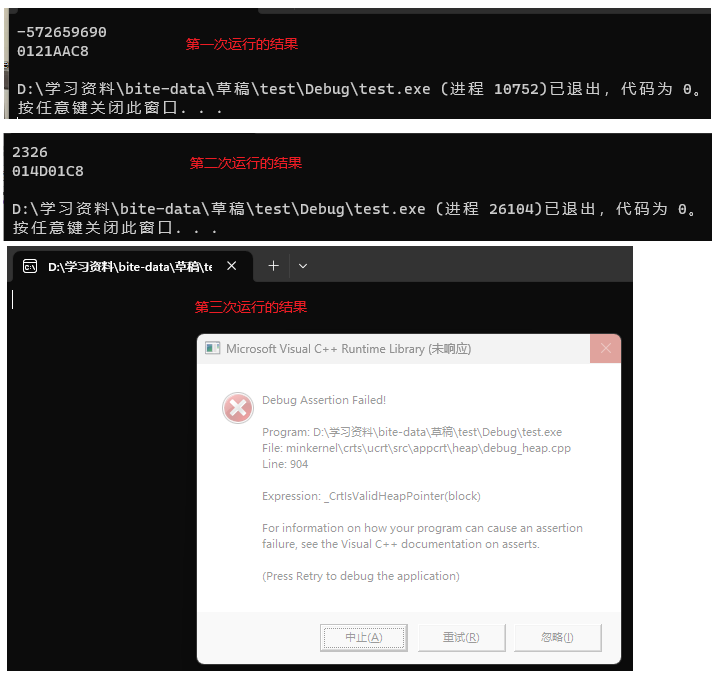
- 原因
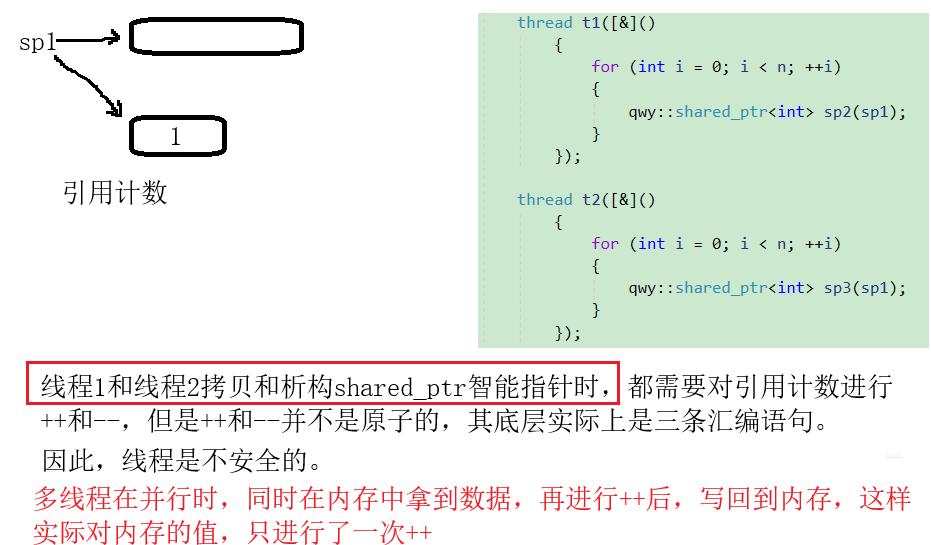
- 注:线程1和线程2并行时,同时拿到引用计数,假设此时的引用计数是2,那么两个线程拿到的都是2,两个线程++后都会得到的引用计数都是3,写回到内存引用计数是3。(实际上此时的引用计数应该是4)
加锁(解决引用计数线程安全问题)
- 用锁对拷贝构造、赋值拷贝、析构中的++或者–进行保护
- 加锁保护之后,则不会再出现上面的线程安全问题
#pragma once
#include <thread>
#include <mutex>
// 1、RAII
// 2、像指针一样使用
// 3、拷贝问题
namespace qwy
{
template<class T>
class shared_ptr
{
public:
// RAII
// 保存资源
// 构造函数
shared_ptr(T* ptr = nullptr)
:_ptr(ptr)
, _pcount(new int(1))
, _pmtx(new mutex) // 私有成员变量中,加了一个锁对象
{}
// 析构函数
// 释放资源
~shared_ptr()
{
Release();
}
// 拷贝构造
// sp2(sp1)
shared_ptr(const shared_ptr<T>& sp)
:_ptr(sp._ptr)
, _pcount(sp._pcount)
, _pmtx(sp._pmtx)
{
// 使用锁对++进行保护
// 多个线程只能够串联执行
_pmtx->lock();
++(*_pcount);
_pmtx->unlock();
}
void Release()
{
// 每个线程都有自己的独立栈结构,因此每个线程都有自己的flag,
// 因此当flag为ture时,是没有线程安全问题的,此时将智能指针对象释放
// 进程的堆空间,全局变量、静态变量是所有线程间共享的
bool flag = false;
_pmtx->lock();
// *_pcount是堆上面的资源
if (--(*_pcount) == 0)
{
delete _ptr;
delete _pcount;
// 当引用计数*_pcount为0时,此时我们不仅需要将_ptr和_pcount进行释放,
// 还需要将锁进行释放,且必须是解锁之后,在释放锁,所以当*_pcount为0时
// 将flag赋值为true,代表我们可以释放锁了
flag = true;
}
_pmtx->unlock();
if (flag == true)
{
delete _pmtx;
}
}
// 赋值拷贝
// sp1 = sp1;
// sp1 = sp2;
shared_ptr<T>& operator=(const shared_ptr<T>& sp)
{
if (_ptr != sp._ptr)
{
Release();
_pcount = sp._pcount;
_ptr = sp._ptr;
_pmtx = sp._pmtx;
// 使用锁对++进行保护
_pmtx->lock();
++(*_pcount);
_pmtx->unlock();
}
return *this;
}
int use_count() const
{
// 智能指针管理的资源的引用计数
return *_pcount;
}
T* get() const
{
return _ptr;
}
// 像指针一样
T& operator*()
{
return *_ptr;
}
T* operator->()
{
return _ptr;
}
T& operator[](size_t pos)
{
return _ptr[pos];
}
private:
T* _ptr;
int* _pcount;
mutex* _pmtx;
};
// shared_ptr 本身是线程安全的。(拷贝和析构时,引用计数++ --是线程安全的)
// shared_ptr 管理资源的访问不是线程安全的,需要用的地方自行保护。
void test_shared_ptr1()
{
int n = 10000;
qwy::shared_ptr<int> sp1(new int(1));
thread t1([&]()
{
for (int i = 0; i < n; ++i)
{
qwy::shared_ptr<int> sp2(sp1);
}
});
thread t2([&]()
{
for (int i = 0; i < n; ++i)
{
qwy::shared_ptr<int> sp3(sp1);
}
});
t1.join();
t2.join();
cout << sp1.use_count() << endl;
cout << sp1.get() << endl;
}
}
加锁(解决智能指针资源线程安全问题)
#pragma once
#include <thread>
#include <mutex>
// 1、RAII
// 2、像指针一样使用
// 3、拷贝问题
namespace qwy
{
template<class T>
class shared_ptr
{
public:
// RAII
// 保存资源
// 构造函数
shared_ptr(T* ptr = nullptr)
:_ptr(ptr)
, _pcount(new int(1))
, _pmtx(new mutex)
{}
// 析构函数
// 释放资源
~shared_ptr()
{
Release();
}
// 拷贝构造
// sp2(sp1)
shared_ptr(const shared_ptr<T>& sp)
:_ptr(sp._ptr)
, _pcount(sp._pcount)
, _pmtx(sp._pmtx)
{
// 使用锁对++进行保护
// 多个线程只能够串联执行
_pmtx->lock();
++(*_pcount);
_pmtx->unlock();
}
void Release()
{
bool flag = false;
_pmtx->lock();
// *_pcount是堆上面的资源
if (--(*_pcount) == 0)
{
delete _ptr;
delete _pcount;
// 当引用计数*_pcount为0时,此时我们不仅需要将_ptr和_pcount进行释放,
// 还需要将锁进行释放,且必须是解锁之后,在释放锁,所以当*_pcount为0时
// 将flag赋值为true,代表我们可以释放锁了
flag = true;
}
_pmtx->unlock();
if (flag == true)
{
delete _pmtx;
}
}
// 赋值拷贝
// sp1 = sp1;
// sp1 = sp2;
shared_ptr<T>& operator=(const shared_ptr<T>& sp)
{
if (_ptr != sp._ptr)
{
Release();
_pcount = sp._pcount;
_ptr = sp._ptr;
_pmtx = sp._pmtx;
// 使用锁对++进行保护
_pmtx->lock();
++(*_pcount);
_pmtx->unlock();
}
return *this;
}
int use_count() const
{
return *_pcount;
}
T* get() const
{
return _ptr;
}
// 像指针一样
T& operator*()
{
return *_ptr;
}
T* operator->()
{
return _ptr;
}
T& operator[](size_t pos)
{
return _ptr[pos];
}
private:
T* _ptr;
int* _pcount;
mutex* _pmtx;
};
// 日期类
struct Date
{
int _year = 0;
int _month = 0;
int _day = 0;
};
// shared_ptr 本身是线程安全的。(拷贝和析构时,引用计数++ --是线程安全的)
// shared_ptr 管理资源的访问不是线程安全的,需要用的地方自行保护。
void test_shared_ptr1()
{
int n = 50000;
qwy::shared_ptr<Date> sp1(new Date);
thread t1([&]()
{
for (int i = 0; i < n; ++i)
{
// 此处_year++,_day++,_month++有线程安全的问题
qwy::shared_ptr<Date> sp2(sp1);
sp2->_year++;
sp2->_day++;
sp2->_month++;
}
});
thread t2([&]()
{
for (int i = 0; i < n; ++i)
{
qwy::shared_ptr<Date> sp3(sp1);
sp3->_year++;
sp3->_day++;
sp3->_month++;
}
});
t1.join();
t2.join();
cout << sp1.use_count() << endl;
cout << sp1.get() << endl;
cout << sp1->_year << endl;
cout << sp1->_month << endl;
cout << sp1->_day << endl;
}
}
- 打印结果
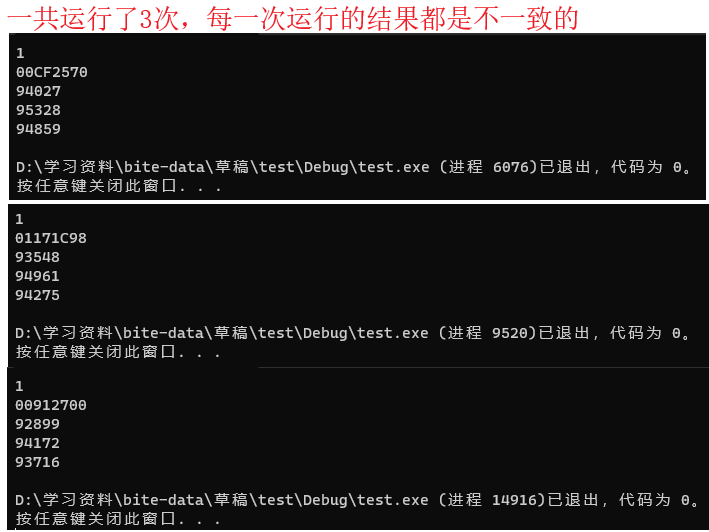
- 解决方法(加锁)
// shared_ptr 本身是线程安全的。(拷贝和析构时,引用计数++ --是线程安全的)
// shared_ptr 管理资源的访问不是线程安全的,需要用的地方自行保护。
void test_shared_ptr1()
{
int n = 50000;
mutex mtx;
qwy::shared_ptr<Date> sp1(new Date);
thread t1([&]()
{
for (int i = 0; i < n; ++i)
{
// 访问智能指针的资源时,进行加锁,避免线程安全的问题
qwy::shared_ptr<Date> sp2(sp1);
mtx.lock();
sp2->_year++;
sp2->_day++;
sp2->_month++;
mtx.unlock();
}
});
thread t2([&]()
{
for (int i = 0; i < n; ++i)
{
qwy::shared_ptr<Date> sp3(sp1);
mtx.lock();
sp3->_year++;
sp3->_day++;
sp3->_month++;
mtx.unlock();
}
});
t1.join();
t2.join();
cout << sp1.use_count() << endl;
cout << sp1.get() << endl;
cout << sp1->_year << endl;
cout << sp1->_month << endl;
cout << sp1->_day << endl;
}
循环引用(shared_ptr的缺点)
#pragma once
#include <thread>
#include <mutex>
// 1、RAII
// 2、像指针一样使用
// 3、拷贝问题
namespace qwy
{
// 智能指针的类模板
template<class T>
class shared_ptr
{
public:
// RAII
// 保存资源
// 构造函数
shared_ptr(T* ptr = nullptr)
:_ptr(ptr)
, _pcount(new int(1))
, _pmtx(new mutex)
{}
// 析构函数
// 释放资源
~shared_ptr()
{
Release();
}
// 拷贝构造
// sp2(sp1)
shared_ptr(const shared_ptr<T>& sp)
:_ptr(sp._ptr)
, _pcount(sp._pcount)
, _pmtx(sp._pmtx)
{
// 使用锁对++进行保护
// 多个线程只能够串联执行
_pmtx->lock();
++(*_pcount);
_pmtx->unlock();
}
void Release()
{
// 每个线程都有自己的独立栈结构,因此每个线程都有自己的flag,
// 因此bool flag = false是没有线程安全问题的
// 进程的堆空间,全局变量、静态变量是所有线程间共享的
bool flag = false;
_pmtx->lock();
// *_pcount是堆上面的资源
if (--(*_pcount) == 0)
{
delete _ptr;
delete _pcount;
// 当引用计数*_pcount为0时,此时我们不仅需要将_ptr和_pcount进行释放,
// 还需要将锁进行释放,且必须是解锁之后,在释放锁,所以当*_pcount为0时
// 将flag赋值为true,代表我们可以释放锁了
flag = true;
}
_pmtx->unlock();
if (flag == true)
{
delete _pmtx;
}
}
// 赋值拷贝
// sp1 = sp1;
// sp1 = sp2;
shared_ptr<T>& operator=(const shared_ptr<T>& sp)
{
if (_ptr != sp._ptr)
{
Release();
_pcount = sp._pcount;
_ptr = sp._ptr;
_pmtx = sp._pmtx;
// 使用锁对++进行保护
_pmtx->lock();
++(*_pcount);
_pmtx->unlock();
}
return *this;
}
int use_count() const
{
return *_pcount;
}
T* get() const
{
return _ptr;
}
// 像指针一样
T& operator*()
{
return *_ptr;
}
T* operator->()
{
return _ptr;
}
T& operator[](size_t pos)
{
return _ptr[pos];
}
private:
T* _ptr;
int* _pcount;
mutex* _pmtx;
};
// 链表的类
struct ListNode
{
int val;
shared_ptr<ListNode> _next;
shared_ptr<ListNode> _prev;
~ListNode()
{
cout << "~ListNode()" << endl;
}
};
void test_shared_ptr2()
{
// n1和n2都是智能指针对象
shared_ptr<ListNode> n1(new ListNode);
shared_ptr<ListNode> n2(new ListNode);
// n1->_next和n2->_prev 也是一个智能指针对象
// 因此当赋值后,n1->_next和n2的引用计数都变为2
// n2->_prev 和 n1同理
n1->_next = n2;
n2->_prev = n1;
cout << n1.use_count() << endl;
cout << n2.use_count() << endl;
}
}
- 打印结果
- 通过打印结果我们可以得知,ListNode并没有被释放(没有打印析构函数中的
~ListNode())

- 原因:循环引用
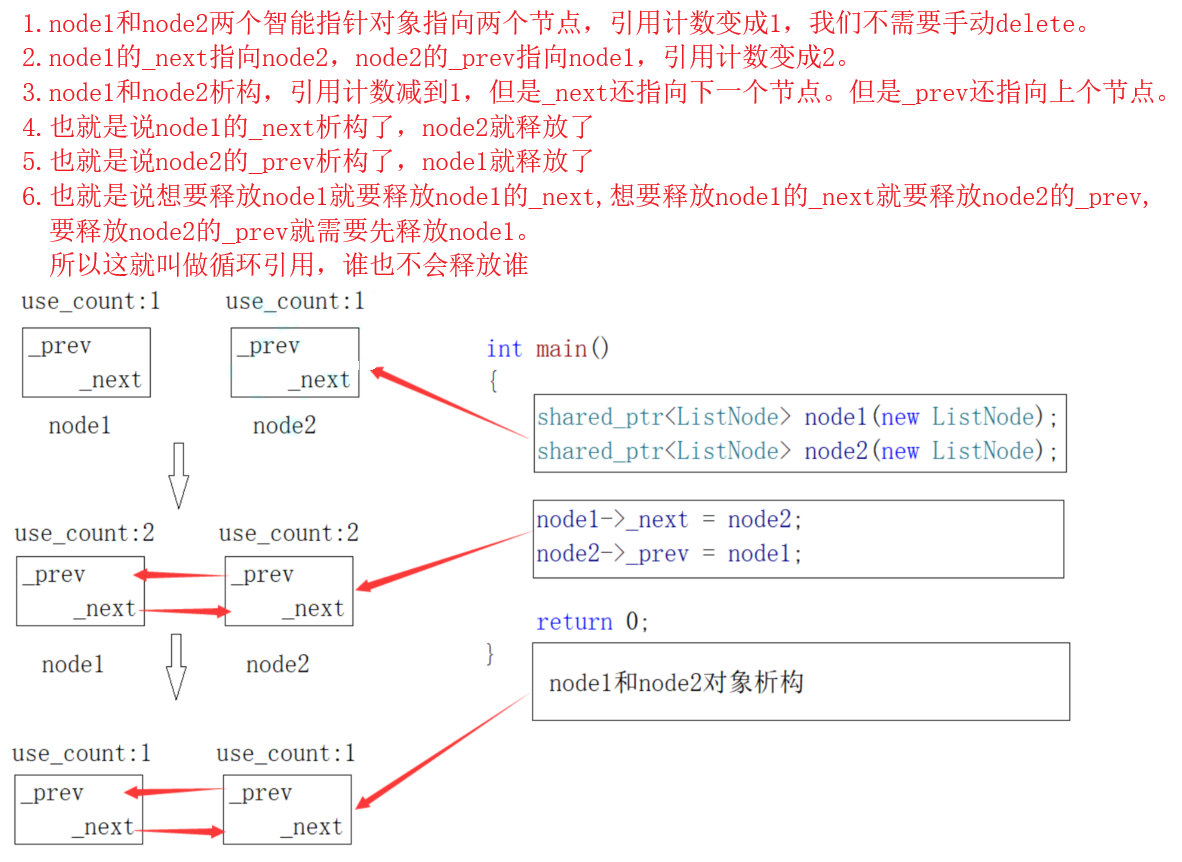
weak_ptr(解决shared_ptr的循环引用问题)
- 注:
#pragma once
#include <thread>
#include <mutex>
// 1、RAII
// 2、像指针一样使用
// 3、拷贝问题
namespace qwy
{
// 智能指针的类模板(shared_ptr的类模板)
template<class T>
class shared_ptr
{
public:
// RAII
// 保存资源
// 构造函数
shared_ptr(T* ptr = nullptr)
:_ptr(ptr)
, _pcount(new int(1))
, _pmtx(new mutex)
{}
// 析构函数
// 释放资源
~shared_ptr()
{
Release();
}
// 拷贝构造
// sp2(sp1)
shared_ptr(const shared_ptr<T>& sp)
:_ptr(sp._ptr)
, _pcount(sp._pcount)
, _pmtx(sp._pmtx)
{
// 使用锁对++进行保护
// 多个线程只能够串联执行
_pmtx->lock();
++(*_pcount);
_pmtx->unlock();
}
void Release()
{
// 每个线程都有自己的独立栈结构,因此每个线程都有自己的flag,
// 因此bool flag = false是没有线程安全问题的
// 进程的堆空间,全局变量、静态变量是所有线程间共享的
bool flag = false;
_pmtx->lock();
// *_pcount是堆上面的资源
if (--(*_pcount) == 0)
{
delete _ptr;
delete _pcount;
// 当引用计数*_pcount为0时,此时我们不仅需要将_ptr和_pcount进行释放,
// 还需要将锁进行释放,且必须是解锁之后,在释放锁,所以当*_pcount为0时
// 将flag赋值为true,代表我们可以释放锁了
flag = true;
}
_pmtx->unlock();
if (flag == true)
{
delete _pmtx;
}
}
// 赋值拷贝
// sp1 = sp1;
// sp1 = sp2;
shared_ptr<T>& operator=(const shared_ptr<T>& sp)
{
if (_ptr != sp._ptr)
{
Release();
_pcount = sp._pcount;
_ptr = sp._ptr;
_pmtx = sp._pmtx;
// 使用锁对++进行保护
_pmtx->lock();
++(*_pcount);
_pmtx->unlock();
}
return *this;
}
int use_count() const
{
return *_pcount;
}
// 拿到share_ptr管理的资源的指针
T* get() const
{
return _ptr;
}
// 像指针一样
T& operator*()
{
return *_ptr;
}
T* operator->()
{
return _ptr;
}
T& operator[](size_t pos)
{
return _ptr[pos];
}
private:
T* _ptr;
int* _pcount;
mutex* _pmtx;
};
// weak_ptr的本质就是将share_ptr管理的资源进行管理
// weak_ptr只负责管理,不负责释放这块资源
// 释放资源还是由share_ptr在合适的时候进行释放
// weak_ptr智能指针的类模板
template<class T>
class weak_ptr
{
public:
// 构造函数
weak_ptr()
:_ptr(nullptr)
{}
// 拷贝构造
// 通过sp.get()拿到shared_ptr管理的资源的指针,这样我们就可以对这块资源进行访问
// 那么我们就需要对这块资源进行管理,也就不用释放这块资源了
weak_ptr(const shared_ptr<T>& sp)
:_ptr(sp.get())
{}
// 赋值拷贝
weak_ptr<T>& operator=(const shared_ptr<T>& sp)
{
_ptr = sp.get();
return *this;
}
// 像指针一样
T& operator*()
{
return *_ptr;
}
T* operator->()
{
return _ptr;
}
public:
T* _ptr;
};
struct ListNode
{
int val;
// 可以指向资源/访问资源,不参与资源管理,不增加引用计数
weak_ptr<ListNode> _next;
weak_ptr<ListNode> _prev;
~ListNode()
{
cout << "~ListNode()" << endl;
}
};
void test_weak_ptr()
{
// n1和n2的引用计数都是1
shared_ptr<ListNode> n1(new ListNode);
shared_ptr<ListNode> n2(new ListNode);
// n1->_next的类型是weak_ptr<ListNode>
// 因此在赋值后,并不会增加n1的引用计数
n1->_next = n2;
n2->_prev = n1;
}
// 出函数的作用域后,先释放n1的资源,在n1中先释放n1的_next,这是一个weak_ptr的智能指针,只是将它管理的资源地址置空
}
// 打印结果为:
~ListNode()
~ListNode()
// 说明将两个ListNode的资源都释放了
定制删除器
- 演示1(正常运行结束)
#include<iostream>
#include<memory>
#include<string>
using namespace std;
int main()
{
// 使用智能指针来管理这个string对象
shared_ptr<string> sp2(new string);
return 0;
}
- 演示2(程序异常)
#include<iostream>
#include<memory>
#include<string>
using namespace std;
int main()
{
// 使用智能指针来管理这个string对象
shared_ptr<string> sp2(new string[10]);
return 0;
}
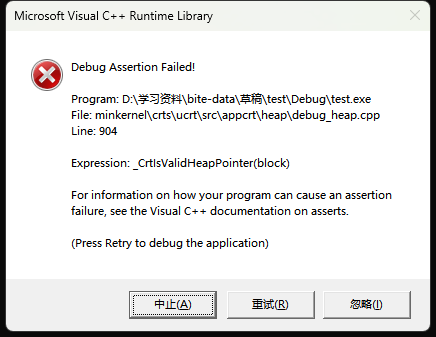
-
这是因为,
shared_ptr内部释放资源使用的是delete,而想要释放string[10],则需要使用delete[],因此需要为智能指针管理的资源定制删除器 -
解决方案(定制删除器)
- 使用定制删除器之后,就可以完美的完成资源的释放
#define _CRT_SECURE_NO_WARNINGS
#include<iostream>
#include<memory>
#include<string>
using namespace std;
// 定制删除器的类模板
template<class T>
struct DeleteArray
{
void operator()(const T* ptr)
{
delete[] ptr;
cout << "delete [] " << ptr << endl;
}
};
int main()
{
// 传入对应的定制删除器
std::shared_ptr<int> sp1(new int[10], DeleteArray<int>());
std::shared_ptr<string> sp2(new string[10], DeleteArray<string>());
// 使用lambda表达式作为定制删除器
std::shared_ptr<string> sp3(new string[10], [](string* ptr){delete[] ptr; });
// 传入关闭文件的定制删除器
std::shared_ptr<FILE> sp4(fopen("Test.cpp", "r"), [](FILE* ptr){fclose(ptr); });
return 0;
}
test_shared_ptr3()
#pragma once
#include <thread>
#include <mutex>
// 1、RAII
// 2、像指针一样使用
// 3、拷贝问题
namespace qwy
{
// 默认删除器的类模板
template<class T>
class default_delete
{
public:
void operator()(T* ptr)
{
delete ptr;
}
};
// shared_ptr的类模板
// class D = default_delete<T> 是定制删除器的缺省模板
template<class T, class D = default_delete<T>>
class shared_ptr
{
public:
// RAII
// 保存资源
// 构造函数
shared_ptr(T* ptr = nullptr)
:_ptr(ptr)
, _pcount(new int(1))
, _pmtx(new mutex)
{}
// 析构函数
// 释放资源
~shared_ptr()
{
Release();
}
// 拷贝构造
// sp2(sp1)
shared_ptr(const shared_ptr<T>& sp)
:_ptr(sp._ptr)
, _pcount(sp._pcount)
, _pmtx(sp._pmtx)
{
// 使用锁对++进行保护
// 多个线程只能够串联执行
_pmtx->lock();
++(*_pcount);
_pmtx->unlock();
}
void Release()
{
// 每个线程都有自己的独立栈结构,因此每个线程都有自己的flag,
// 因此bool flag = false是没有线程安全问题的
// 进程的堆空间,全局变量、静态变量是所有线程间共享的
bool flag = false;
_pmtx->lock();
// *_pcount是堆上面的资源
if (--(*_pcount) == 0)
{
_del(_ptr);
delete _pcount;
// 当引用计数*_pcount为0时,此时我们不仅需要将_ptr和_pcount进行释放,
// 还需要将锁进行释放,且必须是解锁之后,在释放锁,所以当*_pcount为0时
// 将flag赋值为true,代表我们可以释放锁了
flag = true;
}
_pmtx->unlock();
if (flag == true)
{
delete _pmtx;
}
}
// 赋值拷贝
// sp1 = sp1;
// sp1 = sp2;
shared_ptr<T>& operator=(const shared_ptr<T>& sp)
{
if (_ptr != sp._ptr)
{
Release();
_pcount = sp._pcount;
_ptr = sp._ptr;
_pmtx = sp._pmtx;
// 使用锁对++进行保护
_pmtx->lock();
++(*_pcount);
_pmtx->unlock();
}
return *this;
}
int use_count() const
{
return *_pcount;
}
T* get() const
{
return _ptr;
}
// 像指针一样
T& operator*()
{
return *_ptr;
}
T* operator->()
{
return _ptr;
}
T& operator[](size_t pos)
{
return _ptr[pos];
}
private:
T* _ptr;
int* _pcount;
mutex* _pmtx;
// 定制删除器
D _del;
};
// 定制删除器
template<class T>
struct DeleteArray
{
void operator()(const T* ptr)
{
delete[] ptr;
cout << "delete [] " << ptr << endl;
}
};
// 定制删除器
struct Fclose
{
void operator()(FILE* ptr)
{
fclose(ptr);
cout << " 文件关闭 " << ptr << endl;
}
};
struct ListNode
{
int val;
weak_ptr<ListNode> _next;
weak_ptr<ListNode> _prev;
~ListNode()
{
cout << "~ListNode()" << endl;
}
};
void test_shared_ptr3()
{
// 使用的是默认删除器,可以完美的释放资源
qwy::shared_ptr<ListNode> n1(new ListNode);
// 使用默认删除器,是无法释放资源的
// 使用我们自定义的定制删除器则可以完美的释放资源
// 我们的shared_ptr的定制删除器和c++库的简化,因此使用方式不一致,但是效果是一样的
qwy::shared_ptr<ListNode,DeleteArray<ListNode>> n2(new ListNode[10]);
qwy::shared_ptr<FILE, Fclose> n3(fopen("Test.cpp", "r"));
// 但是这种实现方式无法使用lambda表达式
}
}





















 3万+
3万+











 被折叠的 条评论
为什么被折叠?
被折叠的 条评论
为什么被折叠?








